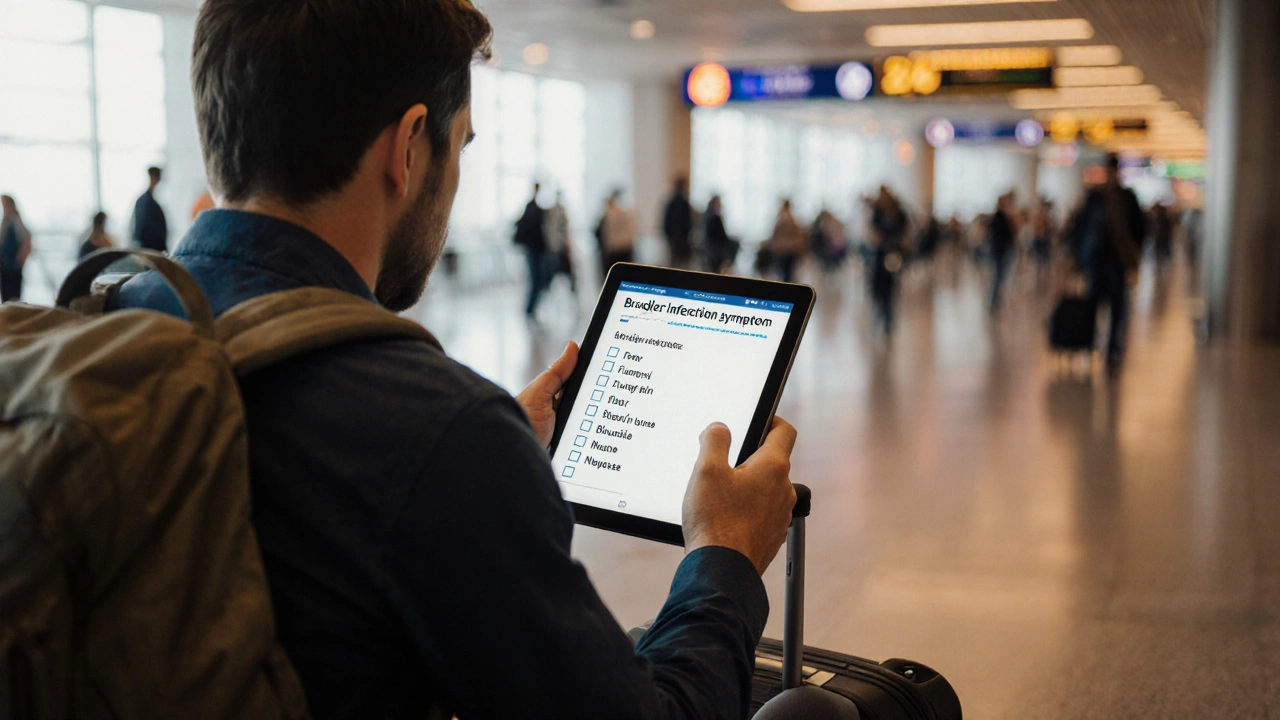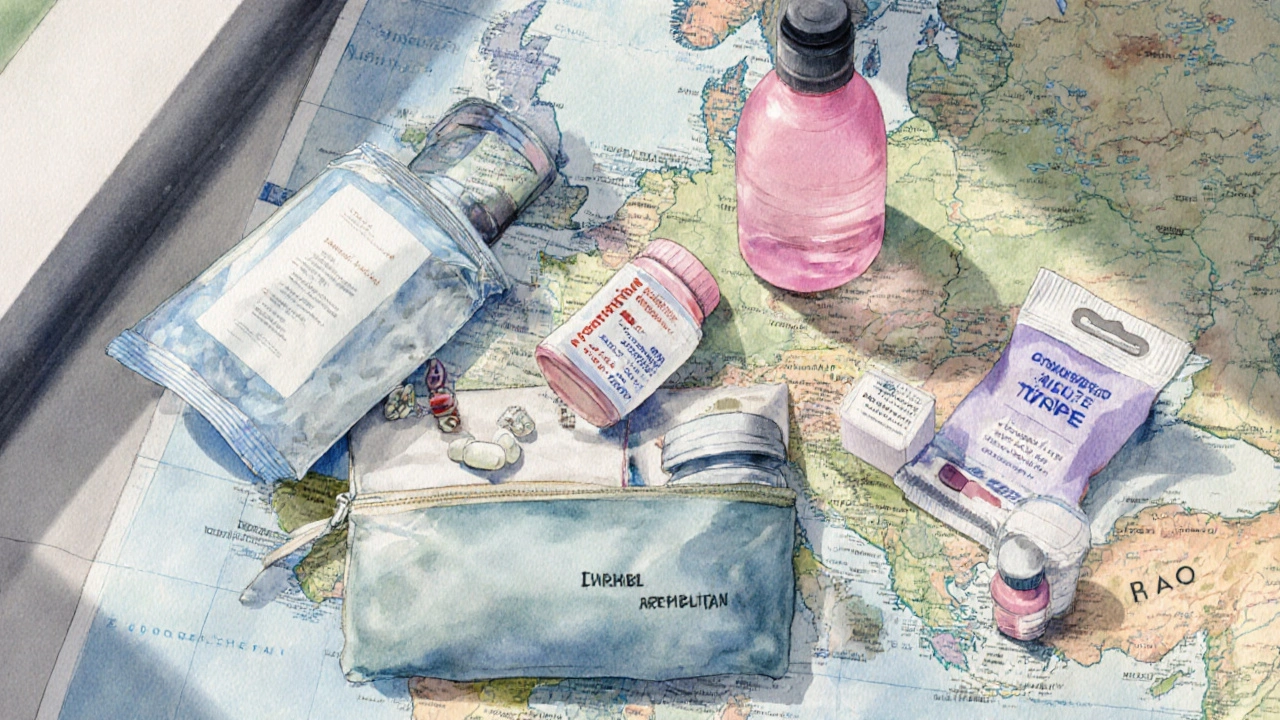Managing Bladder Infections While Traveling: Practical Tips & Care
 Oct, 3 2025
Oct, 3 2025
Bladder Infection Symptom Checker
Check Your Symptoms
Select all symptoms you're experiencing to assess whether you need immediate medical attention.
Your Results
Select your symptoms and click "Check My Symptoms Now" to get personalized guidance.
When a bladder infection (also called a urinary tract infection or UTI) is an inflammation of the bladder caused by bacteria entering the urinary system meets your suitcase, the trip can feel like a race against discomfort. The good news? With a bit of planning, the right supplies, and smart on‑the‑road moves, you can keep symptoms in check and still enjoy the journey.
Quick Takeaways
- Know the red‑flag symptoms that need immediate medical attention.
- Pack a travel‑friendly UTI kit: antibiotics (if prescribed), pain relievers, and a water bottle.
- Stay hydrated, pee often, and practice good hygiene in hotels and public restrooms.
- Locate local pharmacies and clinics before you arrive.
- Use preventive habits-cranberry juice, probiotic foods, and proper clothing-to lower recurrence risk.
Spotting When a Bladder Infection Becomes a Travel Emergency
Most bladder infections start with a burning sensation when you pee, urgency, and mild lower‑abdominal pain. If you notice any of the following, it’s time to seek help right away:
- Fever of 101°F (38.3°C) or higher.
- Flank pain (pain in the back/side) suggesting a kidney infection.
- Blood in the urine that looks pink or cola‑colored.
- Severe nausea, vomiting, or confusion.
These signs indicate the infection may have spread beyond the bladder, and delaying care can lead to serious complications.
Building a Travel‑Ready UTI Kit
The simplest way to stay ahead is to pack a small, organized kit. Here’s what to include:
- Prescription antibiotics such as trimethoprim‑sulfamethoxazole or nitrofurantoin, prescribed by your doctor after a urine culture (carry a copy of the prescription).
- Over‑the‑counter pain reliever like ibuprofen or acetaminophen.
- Phenazopyridine (OTC urinary pain reliever) for symptom relief while waiting for antibiotics to work.
- Reusable water bottle with a built‑in filter-helps you drink enough water without relying on questionable sources.
- Travel‑size antimicrobial wipes for cleaning seat surfaces.
- A small pack of cranberry tablets standardized extract that can help prevent bacteria from sticking to bladder walls.
- Probiotic capsules to support healthy gut flora, which indirectly reduces UTI risk.
Store everything in a zip‑top bag for easy access and to keep moisture out.
Hydration Hacks: Drink Smart, Not Just More
Water does the heavy lifting by flushing bacteria out of the urinary tract. Aim for at least 2‑L of fluid per day, but you don’t have to chug plain water all the time.
- Swap some water for herbal teas like chamomile or nettle, which are gentle diuretics. They keep you hydrated and add a soothing flavor.
- If you’re on a plane, ask for a water bottle after boarding; airline water is usually safe.
- Carry a collapsible bottle that fits in your daypack; refill at trustworthy sources like hotel coffee stations.
Avoid caffeinated or alcoholic drinks in excess-they can irritate the bladder and increase dehydration.
Hygiene Tips for Public Restrooms
Public restrooms are a hot spot for bacterial transfer. Follow these quick steps to keep germs at bay:
- Use a paper towel to turn off the faucet and open the door when you leave.
- Wipe the seat with an antimicrobial wipe before you sit.
- Always pee before and after intercourse, especially on the road.
- Wear breathable cotton underwear; synthetic fabrics trap moisture and promote bacterial growth.
These habits add only a few seconds but cut down on contamination risk dramatically.

Finding Medical Help Abroad
Even with a well‑stocked kit, you might need a local doctor for a proper urine culture or stronger antibiotics. Here’s how to locate help fast:
- Check your travel insurance portal for a list of in‑network clinics. Many policies cover tele‑medicine visits in foreign countries.
- Use apps like Google Maps to search for "pharmacy" or "walk‑in clinic" near your hotel. Look for places with English‑speaking staff.
- If you’re in a non‑English speaking region, carry a card with the phrase "I need a doctor for a urinary infection" translated into the local language.
- Ask hotel staff; they often know the nearest reputable clinic.
When you reach a pharmacy, present your prescription copy. In many countries, pharmacists can dispense antibiotics without a local doctor’s note, but always verify dosage and duration.
Comparing Over‑the‑Counter Relief vs. Prescription Treatment
| Aspect | OTC Options | Prescription Options |
|---|---|---|
| Speed of symptom relief | Provides temporary pain relief (2‑4hours) | Targets underlying bacteria; symptoms improve within 48hours |
| Duration of use | Usually limited to 3‑5days | Full course typically 3‑7days (depends on antibiotic) |
| Risk of resistance | Low (symptomatic only) | Potential if misused; must follow exact prescription |
| Availability abroad | Found in most supermarkets and pharmacies | May require doctor visit or local prescription |
| Cost | Generally inexpensive ($5‑$15) | Varies; insurance may cover partially |
When you’re on a tight schedule, OTC pain relief can buy you a few hours, but antibiotics are the only way to eradicate the infection.
Preventive Habits to Reduce Recurrence During Trips
Even after the infection clears, travelers often face repeat bouts. Incorporate these simple habits into every itinerary:
- Drink a glass of water within an hour after waking and again before bedtime.
- Keep a small bottle of lactobacillus probiotic such as yogurt or a chewable capsule in your bag; it helps maintain healthy vaginal flora.
- Choose loose‑fitting clothing and breathable fabrics for long flights.
- If you’re hiking or camping, bring a portable urine‑collection kit to avoid holding urine for hours.
- Consider a short‑term daily dose of cranberry tablets for the first week of travel.
These steps are low‑effort but provide a solid barrier against bacterial overgrowth.
What to Do If Symptoms Worsen Mid‑Trip
Despite planning, you might notice escalating pain or a new fever. Here’s a quick action plan:
- Stop the activity and find a private restroom.
- Take your prescribed antibiotic (if you have one) with a full glass of water.
- Consume a fast‑acting OTC pain reliever (ibuprofen 200mg).
- Call your travel insurance’s 24‑hour medical line for guidance on nearby clinics.
- If fever exceeds 101°F, seek an urgent care center - don’t wait for the next day.
Document the episode in a travel health journal; noting the date, symptoms, and what helped you recover can be useful for future trips and for your doctor back home.
Travel Insurance: A Safety Net Worth Investing In
Not all policies cover UTI‑related treatment, but many include “medical evacuation” and “out‑of‑network care” that can offset high foreign‑clinic fees. When choosing a plan, verify these points:
- Does it reimburse prescription antibiotics purchased abroad?
- Are tele‑medicine consultations covered?
- Is there a 24‑hour hotline that speaks English?
- What is the maximum out‑of‑pocket limit for medication?
Spending a few extra dollars on a comprehensive plan can save you from unexpected bills and give peace of mind.
Frequently Asked Questions
Can I take antibiotics without a prescription while traveling?
In many countries, pharmacists can dispense certain antibiotics without a local doctor’s note, especially if you show a valid prescription from home. However, regulations vary, so it’s safest to bring a copy of your prescription and check local laws before you travel.
How much water should I drink each day on a trip?
Aim for at least 2liters (about eight 8‑oz glasses) daily. Adjust upward if you’re in a hot climate, exercising, or drinking alcohol.
Is cranberry juice effective for preventing UTIs?
Pure cranberry juice (unsweetened) contains compounds that prevent bacteria from sticking to bladder walls. It helps as a preventive measure but isn’t a cure. For travel, cranberry tablets provide a convenient, sugar‑free option.
What should I do if I develop a fever while abroad?
A fever suggests the infection may have spread to the kidneys. Locate the nearest urgent‑care clinic or hospital, contact your travel‑insurance hotline, and start a prescribed antibiotic as soon as possible.
Can over‑the‑counter pain relievers be used with antibiotics?
Yes. Ibuprofen or acetaminophen can safely be taken alongside most UTI antibiotics. Just follow dosing instructions and avoid exceeding the maximum daily limit.


Liam Mahoney
October 3, 2025 AT 07:13Look, you can't just wing it on a trip and hope a UTI vanishes on its own. It's a matter of responsibility-stay hydrated, pee after every bathroom stop, and actually bring the meds you were too lazy to pack. If you ignore these basics, you're basically inviting trouble. And stop pretending you know everything about "natural remedies" when the science says antibiotics are still king. You owe it to yourself and anyone you travel with to be prepared, not wing‑it like some reckless tourist.
surender kumar
October 11, 2025 AT 06:17Oh sure, because everyone loves a lecture on hydration while they're stuck on a cramped airplane seat. Maybe if you actually read the guide instead of scrolling memes, you'd realize that a reusable water bottle isn't some luxury-it's a lifeline. And yes, the "dramatic" part is that you might actually have to use the restroom before the flight lands, shocking, I know.
Justin Ornellas
December 13, 2025 AT 13:17While I appreciate the moral fervor, let us examine the physiology with due precision. First, the urinary tract is a closed system wherein bacterial colonization occurs primarily via the peri‑urethral route. Second, hydration increases urine output, thereby reducing bacterial load-a fact corroborated by multiple randomized trials. Third, the pharmacokinetics of nitrofurantoin require consistent dosing to maintain therapeutic urinary concentrations. Fourth, phenazopyridine merely masks pain; it does not eradicate pathogens. Fifth, prophylactic cranberry extracts contain proanthocyanidins that inhibit adhesion of Escherichia coli to uroepithelial cells, though the evidence is modest. Sixth, excessive caffeine and alcohol raise bladder irritability, compromising mucosal defenses. Seventh, proper perineal hygiene-front to back wiping-prevents fecal contamination. Eighth, wearing breathable cotton attire reduces moisture retention, a known risk factor for bacterial proliferation. Ninth, seeking medical care promptly when fever or flank pain arise prevents progression to pyelonephritis. Tenth, telemedicine services have become a viable avenue for obtaining prescriptions abroad, provided the patient supplies prior culture data. Eleventh, travel insurance policies often cover urgent care visits, which should be leveraged rather than dismissed. Twelfth, documenting symptom onset and interventions aids both the traveler and the clinician in tailoring therapy. Thirteenth, recognizing the limits of OTC analgesics averts overreliance on superficial relief. Fourteenth, a balanced diet rich in probiotic foods supports a healthy microbiome, indirectly mitigating UTI risk. Fifteenth, the overarching principle is that preparedness, not panic, ensures a smooth journey despite potential bladder infections.
JOJO Yang
October 22, 2025 AT 04:30Wow, you think you can just toss a bottle of water in your bag and call it a plan? That's the kind of half‑baked advice that gets people in trouble. You need a real kit: antibiotics (prescribed by a doc), pain meds, and those wipes for the filthy public loo. Stop acting like a hero who "just vibes" and actually read the guide. The stakes are higher than a cheap souvenir you can forget about.
Faith Leach
December 24, 2025 AT 11:30What they don't tell you is that many governments are quietly suppressing the best UTI‑prevention protocols because the pharmaceutical giants profit from endless antibiotic courses. They want you to buy overpriced pills abroad while they hide the cheap, effective cranberry extracts. If you look deeper, you'll see a pattern: controlled information, limited access, and a push toward unnecessary medical tourism. Stay vigilant, read between the official lines, and don't let the system dictate your health.